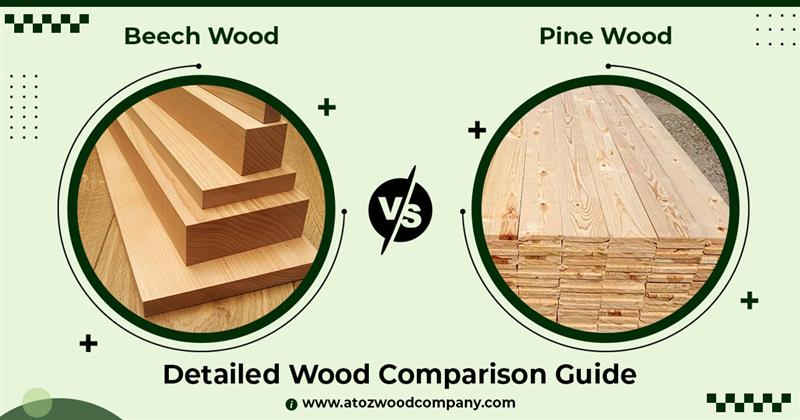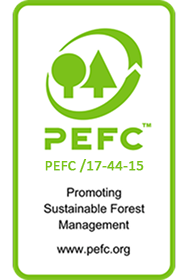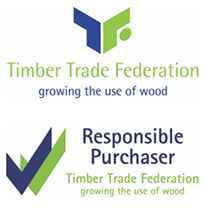Beech and Pine are two popular wood options. While both are widely used, they differ in hardness, durability, appearance, and cost. Understanding their characteristics can help you make the right choice for your project.
Understanding Beech Wood
Beech is a deciduous hardwood tree, native to Europe, Asia, and North America. The wood is known for its smooth texture, subtle grain pattern, and warm, light color. Its density and strength make it a favorite in furniture-making and flooring industries.
Appearance
-
Typically pale cream to pinkish-brown in color
-
Fine, straight grain with a smooth, uniform surface
-
Can be polished to a high sheen, giving a luxurious appearance
Strength & Hardness
-
Beech is dense and hard (Janka hardness ~1,300 lbf)
-
Highly resistant to wear and dents compared to softwoods
-
Excellent for high-traffic areas and furniture requiring durability
Durability & Maintenance
-
Not naturally resistant to decay, insects, or moisture
-
Performs best indoors in controlled environments
-
Requires protective finishes (varnish, oil, or sealants) for extended life
Common Applications
-
High-quality furniture (chairs, tables, cabinets, wardrobes)
-
Flooring, staircases, and veneer panels
-
Plywood, tool handles, and turned wooden products
-
Musical instruments and decorative carvings
Understanding Pine Wood
Pine is a coniferous softwood tree, abundant in Europe, North America, and Asia. It is lighter, softer, and less dense compared to hardwoods, but its affordability and easy workability make it one of the most commonly used woods worldwide.
Appearance
-
Light yellow to pale brown color with visible knots
-
Straight grain with a medium to coarse texture
-
Ages to a rich, golden brown when exposed to sunlight
Strength & Hardness
-
Pine is softer than Beech (Janka hardness ~400–870 lbf depending on species)
-
Easier to dent, scratch, and damage
-
Lightweight, making it easy to transport and handle
Durability & Maintenance
-
Naturally moderate in durability but can be pressure-treated to resist rot and insects
-
Without treatment, it is prone to decay in outdoor conditions
-
Requires painting, staining, or sealing for long-term use
Common Applications
-
Everyday furniture (beds, shelves, cupboards)
-
Paneling, cladding, and interior finishes
-
Doors, windows, and moldings
-
Construction timber and plywood
-
Affordable DIY projects
Beech vs Pine: Detailed Comparison
| Feature | Beech Wood (Hardwood) | Pine Wood (Softwood) |
|---|---|---|
| Wood Type | Hardwood – dense and strong | Softwood – lightweight and softer |
| Color & Grain | Pale cream to reddish-brown, smooth grain | Light yellow to brown, often with knots |
| Hardness | High (~1,300 lbf) – very durable | Low (~400–870 lbf) – easily dented |
| Durability | Moderate indoors, requires sealing | Moderate with treatment, otherwise weak |
| Moisture Resistance | Low – absorbs water easily | Moderate when treated, poor otherwise |
| Workability | Great for bending, shaping, turning | Easy to cut, nail, and paint |
| Weight | Heavy and dense | Light and easy to handle |
| Cost | Higher – premium wood | Lower – budget-friendly |
| Best Uses | Premium furniture, flooring, veneer | Affordable furniture, construction |
Advantages of Beech Wood
-
Superior strength and durability compared to softwoods
-
Smooth, uniform grain for an elegant finish
-
Excellent bending properties for curved furniture designs
-
Long-lasting when properly maintained
-
Ideal for heirloom-quality furniture and heavy-use applications
Advantages of Pine Wood
-
Affordable and widely available
-
Lightweight and easy to work with – great for beginners
-
Takes paints and stains well, offering design flexibility
-
Renewable and eco-friendly when sustainably harvested
-
Widely used in construction due to availability and cost efficiency
Disadvantages of Beech Wood
-
Susceptible to water damage and insect attack without protection
-
Can warp or crack if not dried properly
-
Heavier and harder to transport compared to Pine
-
More expensive than softwood alternatives
Disadvantages of Pine Wood
-
Softer surface – easily dents and scratches
-
Shorter lifespan compared to hardwoods
-
Requires chemical treatment for outdoor use
-
Knots can weaken the structure or cause splitting
Cost Comparison: Beech vs Pine
-
Beech Wood Price: Higher, considered a premium wood for furniture and flooring. Its durability and fine finish justify the cost.
-
Pine Wood Price: Lower, making it one of the most budget-friendly woods in the market. Perfect for mass production and affordable furniture.
Sustainability and Environmental Impact
-
Beech: Harvested from managed hardwood forests, grows slower than Pine, making it less renewable but highly durable.
-
Pine: Fast-growing and widely available softwood, often considered more sustainable due to quick regeneration.
When buying either, it’s crucial to source from suppliers practicing sustainable forestry to minimize environmental impact.
Beech vs Pine: Which Should You Choose?
-
Choose Beech if:
-
You want long-lasting, premium furniture.
-
Durability and elegant finish are top priorities.
-
You are investing in flooring, staircases, or heavy-use furniture.
-
-
Choose Pine if:
-
You want affordable wood for everyday furniture.
-
You need lightweight timber for construction or DIY projects.
-
You plan to paint or stain your furniture for decorative purposes.
-
Conclusion
Both Beech and Pine have their place in woodworking and construction. Beech stands out as a strong, elegant hardwood for high-quality projects, while Pine remains a cost-effective, versatile softwood for mass use and budget-friendly applications.
For businesses and individuals sourcing reliable wood worldwide, AtoZ Wood Company supplies both hardwoods and softwoods, including Beech and Pine, with sustainable harvesting practices and global delivery. Whether you’re looking for premium Beech for luxury furniture or Pine for affordable projects, AtoZ ensures quality and ethical timber supply.
 +237 681 25 6934
+237 681 25 6934




